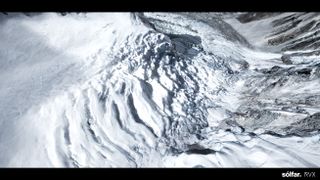Virtual Reality Climbs Mount Everest With The HTC Vive
Experiential virtual reality, as opposed to VR video games, is exciting new terrain. A Bill Clinton VR documentary on eastern Africa had me practically swatting at flies during a demo at Oculus Connect a couple months ago. And this week at a virtual reality event (VRX) in San Francisco, I got to experience Solfar Studio's Everest VR on the HTC Vive.

It's just what it sounds like: a virtual reality endeavor on the great Nepal mountain. I started on the famous Khumbu Icefall, some 18,000 feet high, near the southwest Everest Base Camp. I had panoramic views, and a brief sense of what Mt. Everest must look like in person (just without the brittle cold and the very real danger of an avalanche, but maybe that will come some day).
But so far what I've just described sounds like perhaps just a more personalized version of a 3D film. Instead, Solfar gives you the ability to interact within this virtual Everest world, as well. Using the Vive controllers, I grabbed some guiding rope and gingerly walked across an ice-covered ladder crossing between two mountain peaks. Later, I used my hands (bound to the controllers) to pull myself up a ladder on the side of one snowy cliff. And later, my controllers became magnifying glasses, letting me zoom into various camps for a closer look, and then back out.
Everest VR is in the early stages of development, and what I witnessed was just a taste, but the company expects it to be ready when VR hardware ships early next year. The images come from RVX, a visual effects company that created all of the effects for Everest, the movie. RVX created a library of more than 300,000 high definition images from Everest, and Solfar Studios used Nvidia's Titan X to create detailed 3D models of the mountain using those images.
Solfar is using Unreal Engine 4 for Everest VR, and the version I saw was also using a Titan X, but the final experience will be tuned to run on the minimum PC hardware specs as defined by Oculus. (The extra Nvidia tie-in here, beyond the use of Titan X, is that the company's Gameworks VR will now be integrated into Unreal Engine. However, Everest VR does not yet make use of Gameworks VR. That will come later.)

Solfar Studios, an Icelandic development team made up of a few former CCP Games team members (EVE Online, EVE: Valkyrie, EVE: Gunjack for GearVR), will create several chapters depicting experiences from Base Camp to Lhotse Face to Hillary Step to Everest's summit, all with interactive elements that take advantage of the HTC Vive lighthouse tracking capability, which lets you physically move around within the confines of the tracking, and the Vive controllers, which serve several purposes in the Everest VR experience. These two elements are precisely what's so intriguing about HTC's Vive, as compared to the Oculus Rift.
By moving through some of the different parts of the climb, Solfar Studios will take advantage of some of the physical environment changes and challenges that take place on an actual Everest climb. As with so many of these early VR demos, it begs the question of how long the content creators think people will want to spend inside a headset and experiencing a game or a video or an interactive challenge like Everest, but so far the length of Everest VR hasn't been set.
Stay on the Cutting Edge
Join the experts who read Tom's Hardware for the inside track on enthusiast PC tech news — and have for over 25 years. We'll send breaking news and in-depth reviews of CPUs, GPUs, AI, maker hardware and more straight to your inbox.
In the dozens of VR experiences I've had during the past two years, I've found that first- or third-person movement over landscapes much like Everest have induced a little queasiness, at least for me, but in the 10 minutes I had with Everest VR I didn't experience it, for whatever that's worth.
The following obligatory trailer is really just eye (and ear) candy; it doesn't give you a sense of the interactive experience of Everest VR.
-
RCguitarist Now if only thins can be hooked up to that 360 degree treadmill thing, then I can turn the ac in my house on full blast and really experience it.Reply
Most Popular



